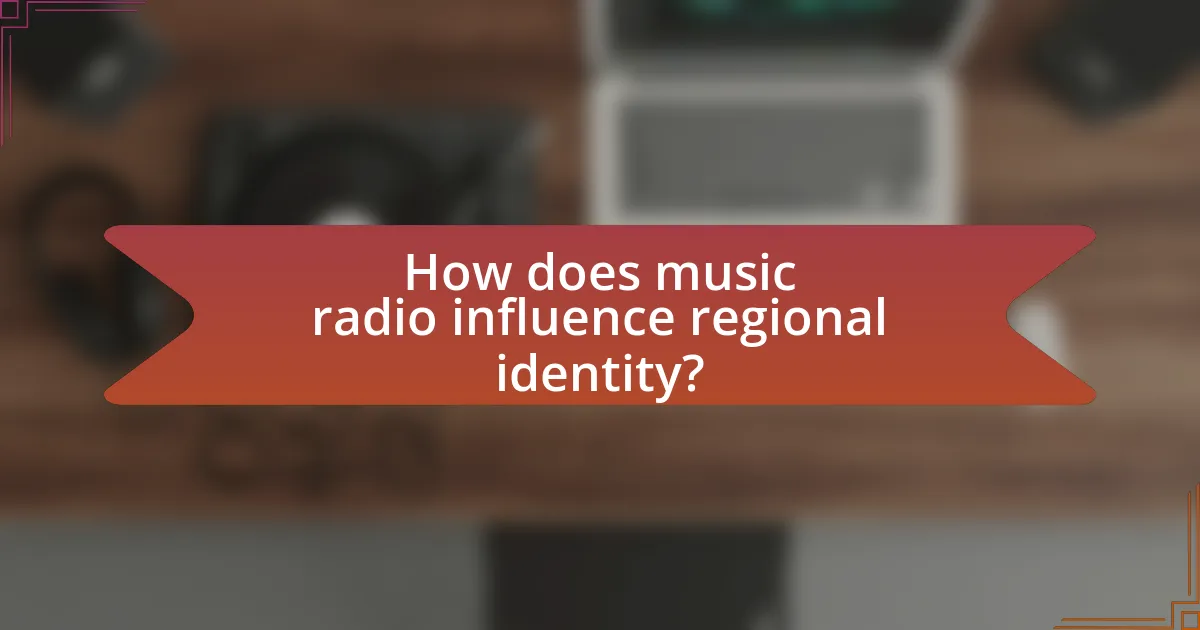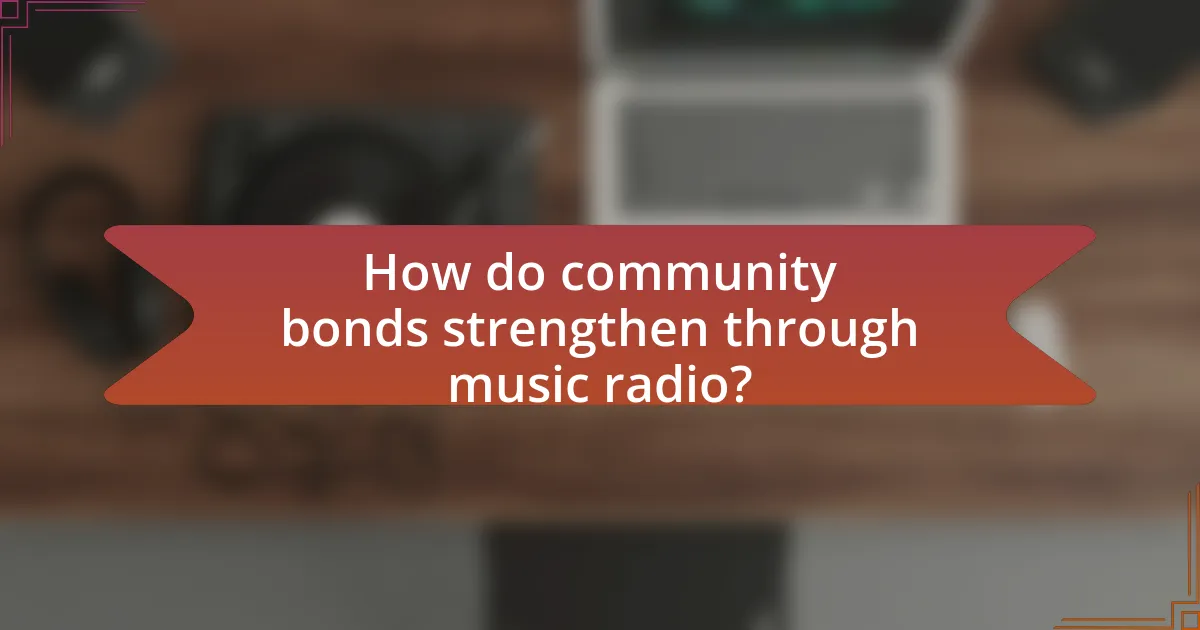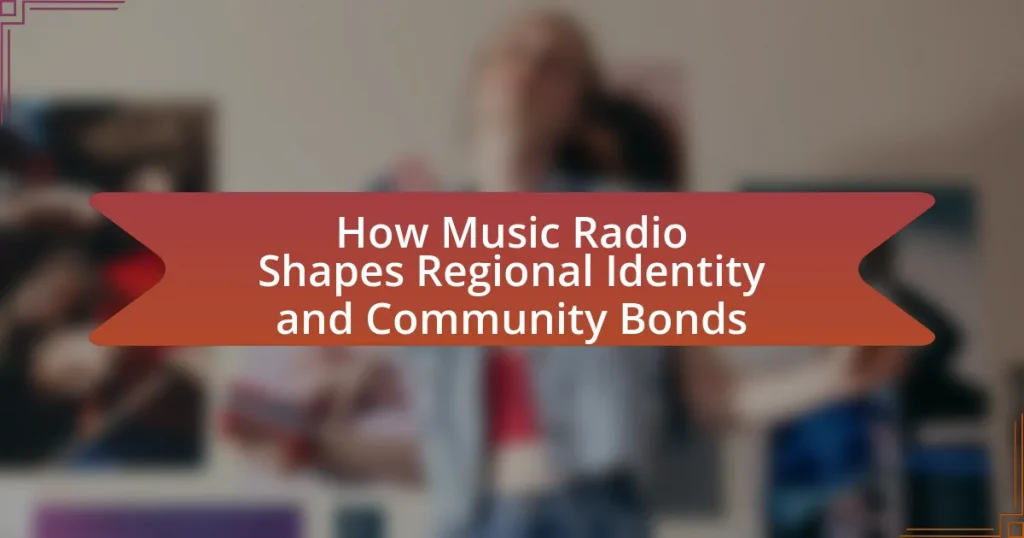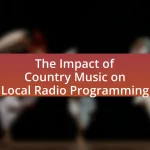The article examines how music radio influences regional identity and community bonds by promoting local culture, music genres, and community engagement. It highlights the role of music in shaping cultural identity, reflecting community values, and preserving local traditions. The discussion includes the impact of listener demographics on programming choices, historical contexts of music radio, and the evolution of radio in different regions. Additionally, it addresses challenges faced by music radio stations, such as competition from digital platforms, and explores strategies for enhancing community engagement through local talent and listener participation. Overall, the article underscores the significance of music radio as a vital platform for fostering social cohesion and a sense of belonging within communities.

How does music radio influence regional identity?
Music radio significantly influences regional identity by promoting local culture, music genres, and community engagement. Through the broadcasting of regional artists and music styles, radio stations help to cultivate a sense of belonging and pride among listeners. For example, stations that feature local folk music or regional dialects reinforce cultural heritage and traditions, thereby strengthening community ties. Research indicates that music radio can enhance social cohesion by providing a platform for local events and discussions, which fosters a shared identity among residents. This connection is evident in studies showing that communities with active local radio stations report higher levels of civic participation and cultural awareness.
What role does music play in shaping cultural identity?
Music plays a crucial role in shaping cultural identity by serving as a medium for expressing shared values, traditions, and experiences within a community. It acts as a vehicle for cultural transmission, allowing individuals to connect with their heritage and each other through shared musical practices. For instance, genres like folk music often reflect the historical narratives and social issues of a particular group, reinforcing a sense of belonging and continuity. Research indicates that music can enhance social cohesion and community bonds, as seen in studies where local music festivals foster regional pride and identity among participants.
How do local music genres reflect community values?
Local music genres reflect community values by embodying the cultural, social, and historical contexts of the communities they originate from. For instance, genres like blues and jazz in the American South express the struggles and resilience of African American communities, highlighting themes of hardship, hope, and social justice. Research indicates that music serves as a vehicle for storytelling, allowing communities to articulate their identity and shared experiences. Furthermore, local music often incorporates regional dialects, instruments, and traditions, reinforcing a sense of belonging and pride among community members. This connection is evident in festivals and local radio stations that promote these genres, fostering community engagement and preserving cultural heritage.
What impact does music radio have on local traditions?
Music radio significantly influences local traditions by promoting regional music styles and cultural narratives. It serves as a platform for local artists, allowing them to share their music and stories, which helps preserve and disseminate traditional sounds and practices. For instance, radio stations often feature folk music, indigenous sounds, and local dialects, fostering a sense of community identity and continuity. Research indicates that communities with active music radio stations report stronger cultural ties and a greater appreciation for their local heritage, as these stations often curate content that reflects the unique traditions and values of the area.
How does music radio foster a sense of belonging?
Music radio fosters a sense of belonging by creating a shared cultural experience among listeners. This medium curates playlists that often reflect local tastes and preferences, allowing individuals to connect with their community’s identity. For instance, local radio stations frequently feature regional artists and genres, which reinforces cultural ties and promotes a collective identity. Research indicates that listeners often feel a stronger connection to their community when they hear familiar music and local news, as highlighted in studies by the Pew Research Center, which found that 70% of respondents feel more connected to their community through local radio. Thus, music radio serves as a vital platform for enhancing social cohesion and belonging within a community.
In what ways does music radio connect listeners to their community?
Music radio connects listeners to their community by providing a platform for local artists, sharing community news, and fostering a sense of belonging through shared musical experiences. Local artists gain exposure through airplay, which helps to promote regional talent and culture. Additionally, music radio stations often feature segments that highlight local events, businesses, and issues, thereby keeping listeners informed and engaged with their community. Research indicates that community-focused radio programming can enhance social cohesion and local identity, as listeners feel a stronger connection to their surroundings when they hear familiar voices and stories on the air.
How do listener demographics affect programming choices?
Listener demographics significantly influence programming choices by determining the content that resonates with specific audience segments. For instance, age, gender, and cultural background shape preferences for music genres, talk shows, and community-focused content. Research indicates that stations targeting younger audiences often prioritize contemporary pop and hip-hop, while those catering to older listeners may focus on classic rock or country. According to a study by the Pew Research Center, 62% of radio listeners prefer stations that reflect their cultural identity, highlighting the importance of tailoring programming to demographic characteristics. This alignment enhances listener engagement and fosters a sense of community, reinforcing regional identity through shared musical and cultural experiences.
What are the historical contexts of music radio in regional identity?
Music radio has historically played a crucial role in shaping regional identity by providing a platform for local music, culture, and community engagement. Since the early 20th century, regional radio stations have broadcasted music that reflects local traditions and tastes, fostering a sense of belonging among listeners. For instance, in the United States, the rise of country music radio in the 1920s and 1930s helped solidify the cultural identity of the Southern states, while stations in the Northeast promoted genres like jazz and folk that resonated with urban populations. This localized content not only reinforced regional pride but also facilitated the preservation of cultural heritage, as seen in the promotion of indigenous music in various countries. Furthermore, music radio has historically served as a communal space where listeners could connect over shared experiences, particularly during significant events such as festivals or local celebrations, thereby strengthening community bonds.
How has music radio evolved in different regions?
Music radio has evolved significantly across different regions, adapting to local cultures, technologies, and listener preferences. In North America, the rise of FM radio in the 1960s allowed for higher sound quality and a shift towards more diverse music formats, leading to the emergence of specialized stations catering to various genres. In Europe, public broadcasting has played a crucial role in promoting regional music and cultural identity, with countries like France and Germany investing in local content to reflect their unique heritage. In contrast, in regions like Africa, music radio has often served as a platform for social change and political expression, with stations using local languages and music styles to engage communities and address social issues. This evolution is evidenced by the increasing number of community radio stations worldwide, which prioritize local content and foster community engagement, demonstrating the integral role of music radio in shaping regional identity and community bonds.
What historical events have shaped music radio’s role in communities?
The establishment of music radio in the early 20th century significantly shaped its role in communities by providing a platform for local artists and fostering cultural exchange. The introduction of the Federal Radio Commission in 1927 regulated broadcasting, ensuring that local stations could serve their communities, which enhanced regional identity. During World War II, radio became a vital source of information and morale, uniting communities through shared experiences and music. The rise of rock ‘n’ roll in the 1950s further solidified music radio’s influence, as it became a voice for youth culture and social change, reflecting and shaping community values. The advent of FM radio in the 1960s improved sound quality and expanded music diversity, allowing local stations to cater to specific community tastes. These historical events collectively illustrate how music radio has been integral in building community bonds and regional identities.

How do community bonds strengthen through music radio?
Community bonds strengthen through music radio by fostering shared experiences and cultural connections among listeners. Music radio serves as a platform for local artists, promoting regional talent and creating a sense of pride within the community. For instance, community radio stations often feature local events, news, and music, which helps to engage listeners and encourage participation in community activities. Research indicates that communities with active music radio stations report higher levels of social cohesion and collective identity, as these stations provide a space for dialogue and interaction among diverse groups. This engagement not only enhances relationships among community members but also reinforces a collective identity rooted in shared musical tastes and cultural heritage.
What community engagement initiatives are supported by music radio?
Music radio supports various community engagement initiatives, including local music showcases, charity events, and educational programs. These initiatives foster community participation and strengthen local identity by promoting regional artists and cultural events. For example, many music radio stations host live performances featuring local musicians, which not only provides exposure for the artists but also encourages community members to engage with their local music scene. Additionally, music radio often collaborates with non-profit organizations to raise funds for community causes, demonstrating its role in social responsibility and community development.
How do music radio stations promote local events?
Music radio stations promote local events primarily through on-air announcements and community engagement initiatives. They frequently broadcast event details during programming, including interviews with event organizers and live coverage, which helps to raise awareness and encourage attendance. Additionally, many stations utilize social media platforms to share event information, engage with listeners, and create promotional contests or giveaways related to local happenings. This multi-channel approach not only informs the audience but also fosters a sense of community by highlighting local culture and activities.
What partnerships exist between music radio and local organizations?
Music radio often partners with local organizations such as schools, non-profits, and community events to enhance regional identity and foster community bonds. These partnerships typically involve collaborations for events like fundraisers, music festivals, and educational programs, where radio stations provide promotional support and coverage. For instance, many music radio stations host local artist showcases in collaboration with community centers, which not only promotes local talent but also strengthens community ties. Additionally, radio stations frequently engage in partnerships with local charities to raise awareness and funds, demonstrating their commitment to community welfare and involvement.
How does music radio facilitate social interaction among listeners?
Music radio facilitates social interaction among listeners by creating shared experiences and fostering community engagement. Through live broadcasts, listeners can connect over shared musical tastes, participate in call-in segments, and engage with social media platforms where discussions about songs and artists occur. Research indicates that music radio serves as a communal space, enhancing social cohesion by bringing together diverse audiences around common interests, such as local music events or cultural celebrations. This interaction is further supported by statistics showing that 75% of listeners feel a sense of belonging to a community through their favorite radio stations, highlighting the role of music radio in strengthening social ties.
What platforms do listeners use to engage with music radio content?
Listeners engage with music radio content primarily through traditional FM/AM radio, online streaming services, and mobile applications. Traditional radio remains a significant platform, with over 90% of adults in the U.S. tuning in weekly, according to Nielsen’s Audio Today report. Online streaming services like Spotify and Apple Music also facilitate access to radio stations and curated playlists, while mobile applications enable listeners to stream their favorite stations on-the-go, enhancing accessibility and engagement. These platforms collectively contribute to the way music radio shapes regional identity and community bonds by providing localized content and fostering a sense of belonging among listeners.
How do listener interactions enhance community ties?
Listener interactions enhance community ties by fostering a sense of belonging and shared identity among individuals. When listeners engage with radio programs through calls, social media, or events, they create a dialogue that strengthens connections within the community. Research indicates that active participation in local radio fosters social cohesion, as listeners feel more connected to their peers and local culture. For instance, a study by the University of Southern California found that community radio stations significantly increase local engagement and participation, leading to stronger community bonds.
What challenges do music radio stations face in building community bonds?
Music radio stations face significant challenges in building community bonds, primarily due to competition from digital platforms and changing listener habits. The rise of streaming services and social media has shifted audience engagement away from traditional radio, making it difficult for stations to maintain a loyal local listener base. According to a 2021 Nielsen report, radio listenership has declined by 10% over the past decade, indicating a shift in how communities connect with music and information. Additionally, limited resources and funding can hinder local programming initiatives that foster community involvement, further isolating stations from their audiences. These factors collectively impede the ability of music radio stations to effectively cultivate and sustain community relationships.
How do technological changes impact listener engagement?
Technological changes significantly enhance listener engagement by providing more interactive and personalized experiences. For instance, the advent of streaming services and mobile applications allows listeners to curate their playlists and access content on-demand, which increases their connection to the music and radio stations they prefer. According to a 2021 Nielsen report, 70% of listeners engage more with radio stations that offer interactive features like song requests and social media integration, demonstrating that technology fosters a deeper relationship between listeners and content providers.
What are the financial challenges for local music radio stations?
Local music radio stations face significant financial challenges primarily due to declining advertising revenue and increased competition from digital platforms. The shift in listener habits towards streaming services and podcasts has led to a decrease in traditional radio listenership, resulting in lower ad sales. According to a report by the Pew Research Center, local radio advertising revenue dropped by 10% from 2019 to 2020, highlighting the financial strain on these stations. Additionally, many local stations struggle with limited budgets, making it difficult to invest in technology and programming that could attract and retain listeners. This financial pressure ultimately threatens their ability to serve as vital community hubs that promote regional identity and cultural bonds.

What are the future trends for music radio and regional identity?
Future trends for music radio and regional identity include increased localization of content, integration of digital platforms, and a focus on diverse musical genres that reflect regional cultures. As music radio evolves, stations are likely to prioritize local artists and community events, fostering a stronger connection with their audiences. The rise of streaming services and social media will enable radio stations to reach wider audiences while still emphasizing regional identity through curated playlists and localized programming. Research indicates that localized content can enhance listener engagement, as seen in studies showing that 70% of listeners prefer music that reflects their local culture.
How is digital technology reshaping music radio’s role in communities?
Digital technology is reshaping music radio’s role in communities by enabling greater accessibility and personalization of content. With the rise of streaming platforms and mobile applications, listeners can now access a diverse range of music and radio stations from anywhere, fostering a sense of global community while still allowing for local engagement. For instance, according to a 2021 report by the Pew Research Center, 57% of Americans listen to online radio, highlighting the shift from traditional broadcasting to digital platforms. This transition allows local stations to reach wider audiences and engage with listeners through social media, creating interactive experiences that strengthen community bonds. Additionally, digital technology facilitates the sharing of local news and events, further embedding music radio into the fabric of community identity.
What new platforms are emerging for music radio content delivery?
New platforms emerging for music radio content delivery include streaming services like Spotify and Apple Music, as well as podcasting platforms such as Anchor and Podbean. These platforms allow users to access curated music playlists and radio-like experiences on-demand, enhancing listener engagement. According to a report by Statista, as of 2023, over 60% of U.S. adults listen to music through streaming services, indicating a significant shift from traditional radio to digital platforms. Additionally, social media platforms like TikTok and Instagram are increasingly being used for music promotion and discovery, further transforming how music radio content is delivered and consumed.
How do social media and streaming services influence local music radio?
Social media and streaming services significantly influence local music radio by altering how music is discovered, shared, and consumed. These platforms enable artists to promote their music directly to audiences, bypassing traditional radio gatekeepers, which leads to a more diverse range of music being played on local stations. For instance, data from the Nielsen Music 2020 report indicates that 70% of listeners discover new music through streaming services, which encourages local radio stations to adapt their playlists to include trending tracks that resonate with their audience. Additionally, social media allows for real-time interaction between listeners and radio stations, fostering community engagement and enabling stations to tailor their content based on listener feedback and preferences. This shift not only enhances the relevance of local music radio but also strengthens regional identity by promoting local artists and genres that reflect the community’s cultural landscape.
What strategies can music radio stations adopt to strengthen community bonds?
Music radio stations can strengthen community bonds by actively engaging with local audiences through events, collaborations, and tailored programming. By hosting community events such as concerts, fundraisers, and local artist showcases, radio stations create opportunities for residents to connect and celebrate their shared culture. Collaborating with local businesses and organizations for sponsorships or promotions fosters a sense of partnership and support within the community. Additionally, programming that highlights local news, events, and artists ensures that the station remains relevant and reflective of the community’s identity. Research indicates that local media involvement enhances community cohesion, as seen in studies showing that community-focused radio can increase civic participation and local pride.
How can music radio leverage local talent to enhance programming?
Music radio can leverage local talent to enhance programming by featuring local artists, hosting live performances, and creating community-focused content. By showcasing local musicians, radio stations can provide a platform for emerging talent, which fosters a sense of community and regional identity. For instance, stations that regularly air music from local artists can increase listener engagement and loyalty, as evidenced by studies showing that local content boosts audience connection. Additionally, hosting events or interviews with local musicians can create a vibrant community atmosphere, further solidifying the station’s role as a cultural hub. This approach not only enriches programming but also strengthens community bonds, as listeners feel a personal connection to the music and artists they hear.
What best practices can be implemented for community engagement?
Best practices for community engagement include fostering open communication, creating inclusive spaces, and utilizing local resources effectively. Open communication encourages dialogue between community members and organizations, ensuring that diverse voices are heard and valued. Creating inclusive spaces allows for participation from all demographics, enhancing the sense of belonging and community cohesion. Utilizing local resources, such as partnering with local artists and organizations, strengthens community ties and promotes regional identity. Research indicates that communities with strong engagement practices experience higher levels of trust and collaboration, leading to more resilient social networks.
How can listeners actively participate in shaping their local music radio?
Listeners can actively participate in shaping their local music radio by providing feedback, requesting songs, and engaging in community events. This involvement allows listeners to influence programming decisions and the types of music featured, which can reflect local tastes and cultural identity. For instance, radio stations often conduct surveys or polls to gather listener preferences, and many encourage direct communication through social media platforms. Research indicates that listener engagement can enhance community bonds, as local radio stations that cater to audience preferences often see increased loyalty and participation in community events, thereby reinforcing regional identity.
What are effective ways for listeners to provide feedback to stations?
Listeners can effectively provide feedback to stations through multiple channels, including social media, direct surveys, and call-in segments. Social media platforms allow listeners to share their opinions instantly and publicly, fostering community discussions around programming. Direct surveys, often conducted by stations, gather structured feedback on listener preferences and satisfaction, enabling stations to tailor their content accordingly. Call-in segments during live shows encourage real-time interaction, allowing listeners to voice their thoughts directly to hosts. These methods not only enhance listener engagement but also help stations understand audience needs, ultimately shaping programming that resonates with regional identity and community bonds.
How can community members contribute to music radio content creation?
Community members can contribute to music radio content creation by submitting original music, participating in interviews, and sharing local music events. By submitting original music, local artists gain exposure and help diversify the station’s playlist, reflecting the community’s unique sound. Participation in interviews allows community members to share their stories and insights, fostering a deeper connection between the radio station and its audience. Additionally, sharing information about local music events helps promote community engagement and supports local musicians, enhancing the station’s role as a cultural hub. This collaborative approach strengthens regional identity and community bonds through shared musical experiences.





